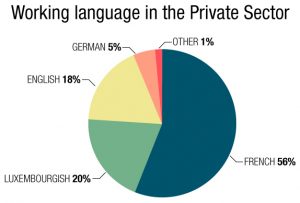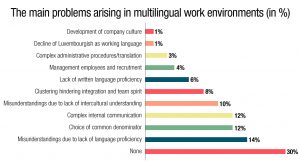Multilingualism at work
Multilingualism was always a defining feature of the social and cultural landscape of Luxembourg, long before the legal recognition of its three official languages in 1984. Today, the high percentage of non-nationals residing in Luxembourg (44.5% in 2013, Statec), as well as the large number of cross-border workers (157.600 in 2013, Statec) further contributes to the diversification of the language situation beyond the official tri-lingualism.
“Multilingualism: driver of competitiveness?” – The Berlitz Study
This complexity has also become a regular feature of work places in Luxembourg, which manifest more and more diversity among their work force – both with regard to languages, as well as nationalities. A study conducted in 2011 by Berlitz Luxembourg surveyed 265 business leaders in the private sector and found that the majority of Luxembourgish work environments were, to varying degrees, multilingual. Only two of the 265 businesses contacted claimed to be monolingual working environments.

The working language is usually chosen on the basis of the common denominator language. This can either be the literal common denominator language, spoken by the majority of the staff, or the language that is understood by most of the staff. The study shows that French is chosen as the common denominator language in 55.8% of the cases; this is partly influenced by the fact that the majority of cross-border workers come from French-speaking regions. Luxembourgish comes second with 20%, followed by English with 17.7% and German with 4.9%. Almost half of the respondents to the study further indicated that compared with 2006, their work environments had become more multilingual.
Multilingualism at work: a Janus-faced phenomenon?
87% of the respondents believed that multilingual workforces and environments constitute a major asset for Luxembourgish businesses by supporting competitiveness on the international market and by attracting highly skilled international workers. From an individual worker’s point of view, language skills constitute a real advantage in a hiring context.
In reality the situation is more complex. Although almost a third of the respondents did not see any disadvantages linked with employing multilingual staff, most participants pointed out several ramifications. The graph below summarizes the most contentious aspects caused by multilingual work environments, as indicated by the respondents:

More technical problems related to communication, translation and language proficiency itself are inevitable consequences of multilingualism. These are aspects that need to be anticipated on the management level of multilingual staff and addressed accordingly.
Respondents also addressed problems related to social contexts. In this light, misunderstandings and miscommunications due to the lack of language proficiency and intercultural understanding were deemed to be major disadvantages of multilingual work environments. Clustering was another social problem highlighted by the respondents, with cliques forming among employees on the basis of their language preferences. Indeed, the three latter aspects can have a negative impact on the working environment by undermining team spirit, as well as by making it more difficult to integrate new staff members into a team.
In reality the situation is more complex. Although almost a third of the respondents did not see any disadvantages linked with employing multilingual staff, most participants pointed out several ramifications. The graph below summarizes the most contentious aspects caused by multilingual work environments, as indicated by the respondents:
Coping with the disadvantages emerging in multilingual work environments
Multilingualism is more than a mere reality for many Luxembourgish companies; it also one of their major assets compared to foreign competitors. In order to support multilingual work environments, there are several means of preventing potential negative aspects or of resolving such issues.
- At management level, company values, as well as the general rules governing equality and team environment in general should be given top priority in order to encourage a team-orientated working environment. Basing the company philosophy on shared values can create a real sense of team spirit, preserving its strength even when translated into different languages.
- The implementation of strong internal communication systems further supports the integration of employees, as well as the communal spirit of the company. This can be achieved by prioritising effective translations or, where necessary, enabling employees to enhance their language skills by encouraging enrollment in language classes. In the context of internal newsletters, it may not always be possible to include all the current workforce languages to an equal extent, however occasional use, however minimal it may be, of languages other than the common denominator language can make co-workers feel more valued.
- In some corporate environments, it may prove difficult to choose a common denominator language, however the main working language of a company should not minimize the importance of other languages or exclude their usage from the work place.
- In spite of the unifying advantage established by a common denominator language, it remains vitally important to promote linguistic diversity, for example by enabling and encouraging employees to enroll in language courses. This may not only contribute to enhancing language proficiency, but also simplify translation and communication procedures in the long run. The Luxembourgish Government has encouraged such initiatives by subsidizing enrolment in Luxembourgish classes at, or supported by, work places since 2003.
- Misunderstandings related to shortcomings in linguistic skills or intercultural understandings cannot always be avoided, but much can be done to support intercultural exchanges within the workforce. This strengthens team spirit as well as interpersonal links between colleagues and creates bonds, which can easily compensate for linguistic shortcomings. Team building can further contribute to enhancing team spirit and avoiding the development of cliques.
In conclusion, multilingualism at the workplace constitutes a major asset for companies and supports their international competitiveness. Even though it can be a Janus-faced phenomenon, entailing several problematic points, it is up to management commitment and involvement to prevent and counter these problems. As is expressed in the quotation below, language skills and cultures might differ in multilingual work environments, however mutual respect and shared values can overcome linguistic and intercultural differences.
It is this original link and this natural complicity that mean that we not only speak the same language, but that we also speak, beyond our differences, the same language: that of principles and values, that of democracy and human rights, that of cultural and linguistic diversity, that of equity and social justice, that of regulation and ethics in economic and financial matters
H.E. Mr Abdou Diouf, Secretary General of La Francophonie
- Graphs based on the figures published in the Berlitz study.
- http://www.statistiques.public.lu/catalogue-publications/luxembourg-en-chiffres/luxembourg-chiffres.pdf
- http://www.berlitz.com/SiteData/docs/WHITEPAPER/b88007bd7fe9b11e/WHITE%20PAPER.MULTILINGUALISM.pdf
- http://www.20mars.francophonie.org/Message-du-Secretaire-general-de-la-Francophonie-20-mars-2013
- http://www.mte.public.lu/formulaires/cours_luxembourgeois/index.html
WANT TO RECEIVE OUR LATEST THOUGHT LEADERSHIP CONTENT?









